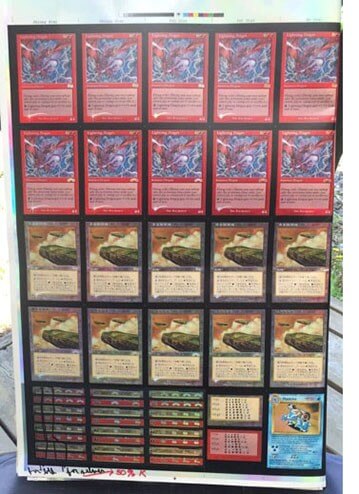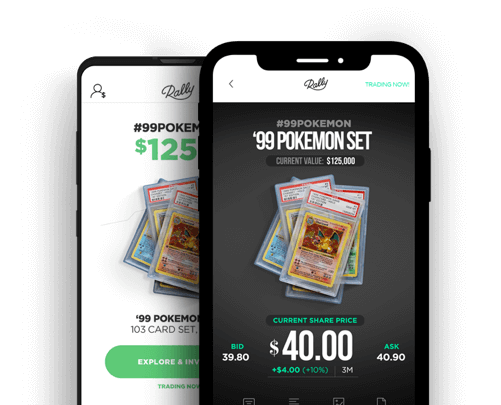Blog > Stories
A Very ’90s Crossover: Pokémon Front and Magic Back

Blog > Stories
A Very ’90s Crossover: Pokémon Front and Magic Back

Magic: The Gathering and Pokémon were the two hottest Card Games of the ‘90s. Individually, their most valuable cards command massive prices today. But in recent years, Pokémon/Magic hybrid cards were uncovered — sparking an investigation and the emergence of one of the most valuable CCG cards in the world.
In 1990, a systems analyst at Boeing named Peter Adkison started a game publishing company called Wizards of the Coast (WotC) based near Seattle. Pursuing his lifelong love of role-playing games (RPGs) like Dungeons & Dragons, Adkison started by releasing RPG-style games and books like The Primal Order.
That first release got them in hot water with Palladium, another publisher who sued WotC over perceived IP infringements. The resulting lawsuit brought the young company to its knees, leaving them on the cusp of bankruptcy just a couple of years after its founding.
After tossing around ideas for a game called ‘RoboRally’ with visiting mathematics professor Richard Garfield, it was decided that production costs would be too expensive and WotC asked Garfield if he had any other ideas up his sleeve. It turns out that he had spent over a decade on a concept for a game that combined baseball cards and traditional card games.

Magic: The Gathering (MTG), the first Collectible Card Game (CCG), was born… though not without hiccups. That original request from WOTC for a cheaper game would prove difficult, considering the massive undertaking necessary for production of a CCG.
WotC was forced to conduct some financial maneuvers, including merging the company with Garfield Games — the shell company set up to protect the IP of MTG — and selling off massive amounts of stock. But eventually, the funds were acquired, and MTG debuted in August 1993 with an initial print-run of 2.6M cards.
In just a few years, MTG exploded in popularity and WotC was actually able to purchase Dungeons & Dragons, bringing things emotionally full circle for Adkison.
Pokémon on the Horizon
About 4,700 miles away in Japan, a new CCG called Pokémon was introduced in October 1996. Soon the brand, which also included a suite of media properties like video games and eventually television shows, experienced a boom that mirrored MTG’s.
Naturally, Nintendo wanted to bring their latest money-maker to the U.S. And who better to license the cards than WotC? After all, they had pioneered the industry and had all the necessary equipment and resources to ramp up production quickly and efficiently in the U.S..
And with that partnership, Pokémania took hold around the world, with 400K packs of cards selling in the first six weeks of their U.S. release (10 times WotC’s projections).

But before that 1999 release, WotC geared up for the production with early tests in 1998, working on perfecting the English Pokémon cards with a Blastoise on the front and MTG backs. For over 15 years, these MTG/Pokémon hybrids were nothing but a rumor.
A Legendary Chimera
That all changed thanks to a September 2016 post in a Facebook group titled #MTGRarities: Major Misprints, Test Prints, Oddities. The group of nearly 65,000 hobbyists still share their expertise on the rarest and most mysterious Magic: The Gathering cards, crowdsourcing investigative work to identify unknown pieces of MTG history.
The post included two examples of these hybrid cards. A few years later, another example emerged — a discovery from a defunct game store’s storage unit.

Experts from the Facebook group convened to assess the authenticity of these cards, utilizing their additional knowledge of Pokémon, as well as detailed comparisons to other cards from the era and inspection under a USB microscope, determining that these oddities were, in fact, legit.
While the CCG community had gone to great lengths to vet the authenticity of these cards, it was still impossible to be sure. Until September 2019, when a former WotC employee named Chris Nitz was tracked down and shown one of the test prints.

According to CGC: “Nitz was the Senior Prepress Systems Analyst for WotC from March 1998 through December 2004. He was also the Lead Typesetter for WotC and helped create numerous Pokémon and Magic products.”Nitz not only confirmed the card was the real deal, but was able to provide images of an uncut sheet including yet another example.


From there, CGC went full mad scientist-mode — using advanced tools like Spot-Fluorescent lighting, UV light, XRF Scanners, and more.

The consensus: All five cards were authentic… meaning they had identified the very first English-language Pokémon cards.
One of the test-prints from this early crop sold in January 2021 for $360K, placing it among the top three most valuable Pokémon cards ever sold. Rally’s CGC 6.5 Pokémon-MTG hybrid is one of just five known to exist.
Sources
“Expensive Pokemon Cards.” CGCCards, www.cgccards.com/news/article/10621/expensive-pokemon-cards/.
“Pokemon Growlithe Magic Back.” CGCCards, www.cgccards.com/news/article/8916/Pokemon-Growlithe-Magic-Back/.
“Pokemon Test Print Blastoise.” CGCCards, www.cgccards.com/news/article/8744/pokemon-test-print-blastoise/.
“It’s Wizards vs. Pokemon as Ex-Partners Square Off.” Seattle PI, seattlepi.com/business/article/It-s-Wizards-vs-Pokemon-as-ex-partnershttps://www.seattlepi.com/business/article/It-s-Wizards-vs-Pokemon-as-ex-partners-square-off-1126716.php-square-off-1126716.php.
“A Brief History of Role-Playing Games.” RPGNet, www.rpg.net/columns/briefhistory/briefhistory1.phtml.









